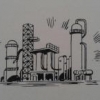Hello friends,
I work as an intern for a natural gas plant. In the ethylene glycol regeneration section, we found recently that the Fe content of the EG entering and exiting the carbon filter is around 4.7-4.8 ppm, which gave the same reading for 2-3 months. There is no foaming issues in the contactor or still. The filter bed was changed 4 months back, which is usually replaced every 6 months.
Is there something to worry about this? If there is some corrosion in the pipelines, there would be a gradual increase in the Fe conc., which we didn't find. Do we need to do BTEX test? I don't think that is necessary.
Please help me as I am new to the industry and does not have much experiences.
Regards,

 FB
FB












